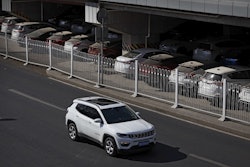The warehouse automation industry is hurrying to utilize technology to keep up with the likes of Amazon. What do warehouse managers or supply chain managers need to know about the various automation options available? How do you know when your efficiency can be increased by adding more machinery, or when automation won’t actually help your process? Manufacturing.net sat down with Adam Kline, product director for warehouse management and supply chain intelligence at Manhattan Associates, for a two-part conversation to try to answer those questions.
This conversation has been edited for length and clarity.
MNET: What kind of robotic assists or automated machines are being rolled out in the supply chain?
Adam Kline: In general, there are two different types with a ton of different subtypes: traditional automation includes conveyance, print-and-applies, maybe unit sorters and put walls and stuff that’s bolted to the ground. You can even put in ASRS [automated storage and retrieval] and shuttle systems, which are more modern and sophisticated. On the other side is where you start to see things that are more dynamic in nature: robotic solutions, collaborative picking bots and those sort of things.
In terms of robotic assists there’s a couple different categories of those as well. We’ve come in contact with a number of vendors. I’ll highlight two of our partners to start. One is Locus Robotics, which provides collaborative picking bots. We are official go-to-market partners with them and have a number of joint installations. Interesting thing about their solutions is they’re not there to replace people. That’s one of the misnomers around robotics in the warehouse. Although some solutions are intended to be a headcount reducer, I think a majority are there to help make people more efficient in the DC and help make your people more efficient. With a traditional goods-to-person system like the old style Kiva [Systems] bots prior to Amazon buying them, the intent was the picking would kind of go away.
Those bots would go from a box to a packing station where people would be at a picking station. With new bots the pickers will still be out and about in the aisles and the bots will come and sort of visit! I say that because there’s a bit of personality with these bots, which is interesting. And the picker will pick into their totes, hit a button and move away. And the bots will go to another area and visit another picker. You have two different resources, the bots and the pickers, both of whom are moving. The pickers are confined to a specific area and the bots are free to move around. That’s a pretty good example of collaborative picking. Interesting thing about it is you are reducing the amount of travel for each picker but not reducing it to zero. The physical movement of goods from rack to tote is still in the picker’s hands. The bots are basically a super flexible conveyance. Locus claims a pretty high improvement in terms of total efficiency in terms of each picker. We need to see more results before quoting their stats, but it seems to be more efficient.
Second is Kindred AI, a picker. Usually you either pick inventory to a put wall or a tote. This bot is a replacement for a put wall. It’s different from what you see in other warehouses because everything is usually straight and this is actually round. When you first see it it’s almost a bit disruptive. When you get closer you see the tote is dumped into a hopper inside this sort-bot, and a robotic arm picks up each individual item. As it picks it up, an array of scanners ensures it gets a good read on the barcode. As soon as it gets the barcode, it sorts to a bin to order. It can keep doing this as items and orders come in. As soon as that is complete, someone can pack it from the other side. You’ve automated the sorting process. These two solutions could work together, although I don’t know if anyone has done it that way.
Some executives I’ve spoken to have said that automation is not a replacement for labor, but a reaction to a dwindling labor pool. Have you seen this across industries?
We absolutely have seen it. Our warehouse management solution has a couple features that are worth bringing up. We have a labor management system as well, which is complimentary. Over the past two to three years we’ve brought our warehouse management and labor management capabilities very close together. You’d be hard pressed to know where one ends and the other starts. All the reasons that you just mentioned have driven us to that decision. I don’t have percentages at my fingertips, but if you look at the number of qualified applications for a given position directionally, they have reduced substantially. One of my peers who manages our labor management solution brought a stat that said a growing number of companies, 25 to 30 percent, are now hiring warehouse workers who have a criminal record. The number of qualified applicants has gone down, so the quality of applicants has gone down. A lot of our clients are looking for alternatives, looking for ways to make their good workers even more efficient.
Like with the sort bots, these are kind of a labor replacement in that particular area as opposed to pick bots that work with people. This doesn’t necessarily come with a headcount reduction, but those workers might be moved around.


















